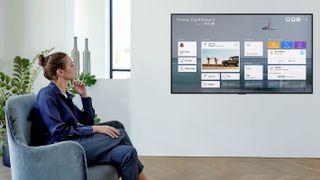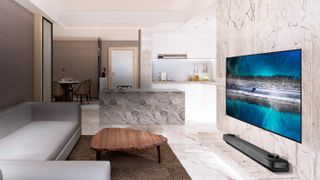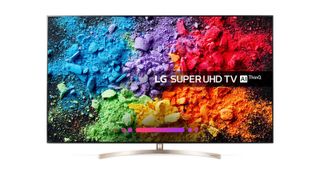The full LG TV 2020 range is now here. The TV maker revealed a number of new sets this year, including affordable LCDs, premium NanoCell sets, flashy OLED TVs, and a number of 8K TVs too.
The Korean electronics company is largely known for being the primary manufacturer of OLED panels. This means you can thank LG for the OLED TVs that are sold by Sony and Panasonic, too. Throughout 2020, LG has continued this legacy with a host of new OLEDs that iterate and improve on what’s come before.
Despite initial production issues, and the effect of a global pandemic on distribution channels, LG has managed to release its 2020 televisions largely on schedule.
Most recently, the entry-level LG BX OLED has now launched worldwide, though we’re still putting together our review to see if it’s worth your hard-earned cash. Then, in the last few months of 2020, LG launched the LG CX OLED TV. We gave this stellar TV an impressive 5 out of 5 stars for its fantastic picture quality, great-looking slim design and value for money.
Take a look at our round-up of all the new LG TVs of 2020 below. Or take a look at our CES 2021 hub. This is where we’ll be putting all the latest rumors and news from the biggest tech expo of the year. If you’re done with 2020 and want to know what’s coming in 2021 instead, we don’t blame you. Although CES will be mostly virtual when it takes place in January 2021, it’ll still be a huge event for showcasing all of the newest and upcoming tech of the next 12 months.
There’s plenty to talk about with this year’s range, too, with an upgraded Alpha 9 Gen 3 processor in most of the new OLED sets, a brand-new Gallery Series GX OLED replacing last year’s LG E9, and flashy 8K models that can upscale HD content to a gorgeous 7680 × 4320 resolution.
With there being so many different models to take in, though, we thought we’d lay out the whole 2020 lineup announced so far, in one (admittedly quite long) piece.
It’s worth noting that specs might change by the time these TVs reach store shelves later this year, but for the most part what you’ll see below are the final specs and features in the final product.
We’ve run through the technological improvements you can expect from 2020 LG TVs, what TV models are actually being introduced, and even the LG’s 2019 sets that are still on sale today.
LG TV 2020 technology: what’s new?
Like last year, the biggest upgrades are the processors: the new Alpha 9 Gen 3 AI and Alpha 9 Gen 3 8K AI. The former uses a four-step upscaling algorithm while the latter uses a six-step process to reduce noise and enhance the picture.
Beyond the new processor and additional 8K models, the LG 2020 lineup is the first time we’ll see a new 48-inch OLED screen size for the CX OLED. We now have a price tag for the 48-inch model, which – at $1,499 / £1,499 (around AU$2,060, with an Australia model incoming) – isn’t as cheap as we hoped. However, it still bodes well for the gradually lowering prices of OLED TVs in general.
LG OLED vs Nano Cell
Basically, OLED and Nano Cell describe what kind of backlight or panel technology each TV uses.
OLED uses organic light-emitting diodes in each pixel to create virtually unlimited contrast (a pure white pixel next to a totally black pixel next to it, for example) but is limited by its peak brightness.
Nano Cell uses an LED-LCD screen with quantum dot-like technology to enhance color saturation, reach higher peak brightness and offer wider viewing angles than traditional LED-LCD.
The real budget buy, the LG BX OLED, starts at a slightly lower $1,399 / £1,299 / AU$2,795, though doesn’t appear to have a 48-inch size.
On the software side of things, the webOS smart TV platform will be getting a number of tweaks that will make getting to content quicker and easier like Sports Alert that lets you track when your favorite team is playing, get live updates from their games and lets you jump to that game whenever it comes on if it’s available.
Lastly, at least a few LG OLED TVs are capable of utilizing Dolby Vision IQ, a new technology that uses a built-in light sensor on the TV and Dolby Vision dynamic metadata to optimize picture quality for the amount of ambient light in the room. Don’t expect HDR10+, though, which LG doesn’t support.
We’re told that the the new a9 Gen 3 chip will implement a face-recognition algorithm – though not for you! This just means the processor will be better at flagging faces onscreen and applying suitable processing for color accuracy and to help them stand out from the background.
LG has slipped up slightly when it comes to app support – in the UK at least. While LG usually support the full suite of Freeview Play catchup apps, it launched its 2020 range without it, with BBC iPlayer / BBC News / BBC Sport only coming later in the year. At the time of writing, All4, My5, and ITV Hub are all missing.
OLED
LG 2020 OLED TVs
LG BX Series OLED
Model Numbers: LG 55OLEDBX, 65OLEDBX
The most affordable LG OLED is the one that, unfortunately, comes out the latest – though it finally launched in early September. The LG BX OLED is available in two sizes so far (55- and 65-inch), with a 77-inch model likely coming down the line.
As the cheapest member of the OLED family, the BX will use the slightly less powerful a7 Gen 3 Processor instead of the a9, which means it doesn’t benefit from AI upscaling, a pretty essential feature if you’re thinking about buying at a larger size.
However, last year’s B9 didn’t suffer much in the picture department, and the BX is likely to be a smart buy this year too – especially since it’s retailing at just $1,399 / £1,299 / AU$2,795 for a 55-inch size, significantly less than its B9 predecessor did at launch. The larger 65-inch model costs $2,099 / £1,999 / AU$3,795.
You can expect our review in the coming weeks – until then, hold tight!
LG CX Series OLED
Model Numbers: LG 48OLEDCX, 55OLEDCX, 65OLEDCX, 77OLEDCX
One step above the entry-level BX series is the 2020 CX OLED, a successor to last year’s award-winning LG C9 OLED, and the first TV in the OLED lineup to use the alpha 9 Gen 3 Processor. As we mentioned earlier this is the first time LG is offering a 48-inch version of the TV, so if you’ve wanted a slightly smaller OLED for your bedroom, the new CX OLED is one to forward to. It sits on a unibody stand or can be wall-mounted.
Prices start at $1,799 / £1,799 (around AU$2,500) for the 55-inch model, with a 65-inch model costing $2,499 / £2,799. There’s a bigger 77-inch version (price TBA) and more compact 48-inch model (£1,499 / probably $1,499) too.
Read our full LG CX OLED review
LG GX ‘Gallery’ Series OLED
Model Numbers: LG 55OLEDGX, LG 65OLEDGX, LG 77OLEDGX
So, slight change in the lineup this year – there’s no E Series OLED in 2020. Instead what we get is the new GX ‘Gallery’ Series OLED that mounts on the wall and has ports located right on the back. It’s a similar design to the W-Series ‘Wallpaper’ design you might have seen in past years, but by integrating the ports right into the TV instead of an attached soundbar, you’re able to hook the TV up to whichever sound system you’d like. It’s also worth noting that this is the first TV in the range to support ATSC 3.0.
Prices start at $2,699 / £2,299 (around AU$4,500) for the 55-inch model, with a 65-inch (April) and 77-inch (May) model available too.
Read our hands-on LG GX OLED review
LG WX ‘Wallpaper’ Series OLED
Model Number: LG 65OLEDWX
That said, you’ll still see a single new model of the LG WX ‘Wallpaper’ Series in 2020, available in a 65-inch screen size for £4,499 (around $5,600 / AU$9,200) from April.
Like years prior, it will still use an attached Dolby Atmos soundbar as a hub for inputs and outputs and need to be mounted. If you want something bigger than 65-inches, LG says that the 77-inch version of the W9 OLED will be available this year as well. It also supports ATSC 3.0.
Read our comparison piece: LG GX vs LG WX OLED: which should you choose?
LG Signature ZX 8K OLED
Model Number: LG 77OLEDZX, LG 88OLEDZX
The penultimate OLED this year is the LG Signature ZX – LG’s only 8K OLED TV. Because it’s 8K, it uses the higher-end Alpha 9 Gen. 3 8K AI chip with deep learning to offer better upscaling to fill all those pixels and hands-free voice control thanks to a built-in microphone that responds to ‘Hi LG’. It was easily one of the best TVs we saw at CES 2020 this year, and we can’t wait to try it out in our own home later this year.
Prices start at £24,999 (around $30,100 / AU$51,000) for the 77-inch model, though the 88-inch model is launching first for £39,999 (around $50,000 / AU$82,000) in May.
LG Signature RX ‘Rollable’ OLED
Model Number: LG 65OLEDRX
OK, so the Rollable OLED TV missed its debut in 2019 but LG has said repeatedly that this will be the year that you’ll be able to buy the Rollable OLED with the new Alpha A9 Processor in it. That’s the good news.
The bad news is that it only comes in a single screen size – 65-inch – that could cost upwards of $60,000 (around £48,000 / AU$99,000). It also won’t be ATSC 3.0-ready, which could be a real disadvantage once stations start broadcasting in 4K HDR. Still, if you’re absolutely loaded and want the coolest TV in town, the Rollable OLED fits the bill.
Read our hands on LG RX Rollable OLED review
NanoCell
LG 2020 Nano Cell TVs
LG Nano85 Series
Available screen sizes: 49-inches, 55-inches, 65-inches, 75-inches
Dropping down from OLED TVs to Nano Cell LED-LCDs, the first entry in the lineup is the LG Nano85. This series will use the Alpha A7 Gen. 3 Processor and have a native 120Hz refresh rate. It’s also capable of displaying Dolby Vision content as well as passing on Dolby Atmos signal to a compatible sound system.
That’s something all the OLED TVs can do, so it’s nice to see it in the more affordable entry-level Nano Cell series. The only downside to this model is that it uses edge-lit LEDs instead of a full array panel which will definitely take a toll on contrast, but again, you get what you pay for.
LG Nano90 Series
Available screen sizes: 55-inches, 65-inches, 75-inches and 86-inches
The LG Nano90 is one step up from the LG Nano85 and the big change is that it uses a full-array panel for better contrast and comes in a larger, 86-inch screen size. Otherwise it has all the same specs and features as the LG Nano85.
UK pricing starts at £1,299 (around $1,600 / AU$2,700) for the 55-inch model, available from late April.
Don’t miss our LG Nano90 review
LG Nano97 Series
Available screen sizes: 65-inches and 75-inches
Going up one more step is the LG Nano97. It’s the first 8K TV in the Nano Cell lineup and uses the Alpha A9 Gen. 3 8K AI Processor. Unlike the lower-end Nano Cell TVs, the Nano97 will also incorporate the built-in microphone and responds to ‘Hi LG’.
LG Nano99 Series
Available screen sizes: 65-inches and 75-inches
The highest-end Nano Cell TV is the LG Nano99 – another 8K LED-LCD screen and the best one in LG’s 2020 lineup. It only comes in two sizes, but both use LG’s Full Array Dimming Pro technology to give even better black levels and contrast. We’ll have to test it to see how much of a difference it makes, but if you’re afraid of burn-in and really want an 8K LED-LCD, this is probably the model to pick.
The 75-inch model launches first in late April, for £5,499 (around $6,800 / AU$11,300), with a cheaper 65-inch model coming in June.
LG UHD 2020 TV lineup
LG UN6900/UN6970 (US)
Available screen sizes: TBD
The cheapest TV you’ll be able to buy from LG in 2020 is the UN6900/UN6970 – at least in the US. The UK and Australia will get their own budget UHD TVs with most of the same specs, but there’s likely to be some regional variation as well. In the US, expect these TVs to use Active HDR, the basic version of WebOS and a Quad-Core processor. Unfortunately they only have a native refresh rate of 60Hz and use a basic IPS panel.
LG UN7300/UN7370 (US)
Available screen sizes: TBD
It’s not a massive step up from the UN6900 but the UN7300 will add smart assistants (Google, Alexa and Siri through AirPlay 2) as well as Sports Alert through WebOS. Unfortunately there’s no Dolby Vision support at this level and the panel runs at a native 60Hz. Both those specs change with the next step up, thankfully.
LG UN8500/8570 (US)
Available screen sizes: TBD
The highest-end regular UHD TV from LG in 2020 (at least for US customers) is the UN8500 that adds Dolby Vision IQ to the TV as well as the Alpha a9 Gen. 3 Processor. The panel gets upgraded to 120Hz at this level and has some form of local dimming. It’s not going to be as good as the Nano Cell TVs above it, but if your budget is very limited, these will probably offer the best bang for your buck.
2019
LG 2019 TVs: what’s leftover from last year?
What you see up above are all the new models for 2020 – that said, you’ll still be able to find plenty of 2019 screens in stores for the next few months. Here are the TVs from last year with their sale prices in case any of them catch your eye.
LG OLED Z9 (available in 88 inches): As the flagship LG OLED – or at least, the flagship that doesn’t curl up into a box – the LG OLED Z9 is an 8K powerhouse with big promises for 8K upscaling and ‘improved noise reduction’ for clean, smooth images. With 33 million pixels across 88 inches of screen, it’ll certainly have to work hard to do it – and the a9 Gen 2 processor will surely come in handy.
Read our full review: LG 8K OLED
LG OLED W9 (available in 65, 77 inches): The W9 upgrade to last year’s LG W8 will come with the new a9 Gen 2 processor’s improvements to High Frame Rate, HDR, and overall picture and sound processing – as well as the same thin, picture frame shape that made this ‘wallpaper’ television series so attractive. The W8 came with a 60W 4.2 Dolby Atmos soundbar built in to the set, so we’re likely to see similar audio credentials for this model. The 65-inch model will retail at $6,999 / £6,999 (around AU$9,800) while the 77-inch jumps up to $12,999 / £12,999 (around AU$18,300).
US models: OLED65W9PUA, OLED77W9PUA
UK models: OLED65W9PLA, OLED77W9PLA
LG OLED E9 (available in 55, 65 inches): If last year is anything to go by, the new E Series model will feature the same specs at the W9, but with a glass body and tacked-on chassis instead of the W8’s ‘wallpaper’ design. Expect a $3,299 / £2,799 (around AU$4,600) price tag for the 55-inch, and $4,299 / £3,499 (around AU$6,050) for 65 inches.
US models: OLED55E9PUA, OLED65E9PUA
UK models: OLED55E9PLA, OLED65E9PLA
Read our full review: LG OLED E9
LG OLED C9 (available in 55, 65, 75 inches): The newest C Series model is confirmed, and experience teaches us to expect a neat balance of performance and price, without ditching the company’s latest processor to do it. Last year’s LG C8 came with a 2.2 soundbar too. Sets will retail at $2,499 / £2,499 (around AU$3,500) for the 55-inch, $3,299 / £3,299 (around AU$4,600) for the 65-inch, or $6,999 / £7,499 (around AU$9,800) for the 77-inch.
US models: OLED55C9PUA, OLED65C9PUA, OLED77C9PUA
UK models: OLED55C9PLA, OLED65C9PLA, OLED77C9PLA
Read our full review: LG OLED C9
LG OLED B9 (available in 55, 65, 77 inches): The cheapest OLED in LG’s 2019 TV range was late to the party, but is now available to buy. It carries the same panel as its more premium siblings, though with an older a7 Gen 2 chip instead of the latest a9 Gen 2 – and cheaper build too.
UK models: OLED55B9PLA, OLED65B9PLA (available)
US models: OLED55B9PUA, OLED65B9PUA (no release date)
Read our full review: LG B9 OLED
SM9500 / SM9800 (available in 55, 65 inches): More NanoCell, less processing. The LG SM9500 (SM9800 in the UK) packs in the 2nd-generation Alpha 7 processor, rather than the Alpha 9, but comes with Full Array Dimming Pro for more uniform black levels, as well as Dolby Vision and Dolby Vision, and LG’s ThinQ AI smart platform. No Dolby Atmos soundbar, though.
UK release: The 55-inch and 65-inch models launched in May for £1,999 / £2,999.
US release: Retailing now, at $2,699 for the 65-inch model.
Read our full review: LG SM9500 TV
SM9000 (available in 49, 55, 65, 75 inches): One step below the previous model, with the same a7 Gen 2 processor, but Full Array Dimming rather than the upgraded ‘Pro’ technology seen on the SM9500 – meaning less lighting control and less consistent brightness.
UK release: The three smaller models (49, 55, 65 inch) are all available in April, for £1,499 / £1,799 / £2,499 – while the 75-inch launches in May for £2,999, and the 86-inch model launches in July for £4,499.
US release: Listed in 55 and 65-inch sizes in the US, which are retailing now at $1,399 and $1,999 respectively.
SM8600 / SM8500 (available in 49, 55, 65, 75 inches): An update to last year’s new SK8500 range, these models sticks with the a7 Gen 2 processor, but with a generally cheaper design and only more basic Local Array dimming zones rather than the Full Array Dimming of the more costly models. The only difference between the SM8600 and SM8500? The TV stand.
UK release: The 49, 55, and 65-inch models land in late April. We’ve been given a price range of £1,299 / £1,499 / £2,299 for the three sets, while the 75-inch SM8600 model arrives in early May at a higher £2,999.
US release: Only 49, 55, and 65-inch models confirmed, currently listed at $799 / $999 / $1,499 in the US.



















Comments are closed.